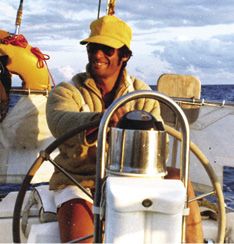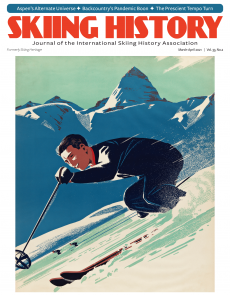SKIING HISTORY
Editor Greg Ditrinco
Consulting Editor Seth Masia
Art Director Edna Baker
Editorial Board
Seth Masia, Chairman
John Allen, Andy Bigford, John Caldwell, Jeremy Davis, Kirby Gilbert, Paul Hooge, Jeff Leich, Bob Soden, Ingrid Wicken
Founding Editors
Morten Lund, Glenn Parkinson
To preserve skiing history and to increase awareness of the sport’s heritage
ISHA Founder
Mason Beekley, 1927–2001
ISHA Board of Directors
Chan Morgan, Chairman
Seth Masia, President
Wini Jones, Vice President
Jeff Blumenfeld, Vice President
John McMurtry, Vice President
Chan Morgan, Treasurer
Einar Sunde, Secretary
Richard Allen, Skip Beitzel, Michael Calderone, Art Currier, Dick Cutler, Chris Diamond, David Ingemie, Joe Jay Jalbert, Rick Moulton, Wilbur Rice, Charles Sanders, Bob Soden (Canada)
Presidential Circle
Christin Cooper, Billy Kidd, Jean-Claude Killy, Bode Miller, Doug Pfeiffer, Penny Pitou, Nancy Greene Raine
Business & Events Manager
Kathe Dillmann
P.O. Box 1064
Manchester Center VT 05255
(802) 362-1667
kathe@skiinghistory.org
Membership Services
Laurie Glover
(802) 375-1105
laurie@skiinghistory.org
Corporate Sponsorships
Peter Kirkpatrick
(541) 944-3095
peterk10950@gmail.com
Bimonthly journal and official publication of the International Skiing History Association (ISHA)
Partners: U.S. Ski and Snowboard Hall of Fame | Canadian Ski Museum and Hall of Fame
Alf Engen Ski Museum | North American Snowsports Journalists Association | Swiss Academic Ski Club
Skiing History (USPS No. 16-201, ISSN: 23293659) is published bimonthly by the International Skiing History Association, P.O. Box 1064, Manchester Center, VT 05255.
Periodicals postage paid at Manchester Center, VT and at additional mailing offices. Postmaster: Send address changes to ISHA, P.O. Box 1064, Manchester Center, VT 05255
ISHA is a 501(c)(3) public charity. EIN: 06-1347398
Written permission from the editor is required to reproduce, in any manner, the contents of Skiing History, either in full or in part.
Ski Business: Better Than Wool
In the early ’80s, skiers finally learned to stay dry and warm.
Photo above: In the 1980s, Patagonia's fleece top helped launch the technical skiwear category.
Those of us who began skiing before 1980 remember bundling up in layers of nylon, wool and down. In dry weather we were warm. In wet weather we shivered and headed for the lodge, then waited overnight for the soggy insulation to dry out. Around 1970 a lot of ski parkas were made with synthetic fiberfills, which dried more quickly—but they still soaked up cold rain and wet snow, driving us indoors.
Forty years ago, in 1981, everything changed. We got polyester fleece, which resisted moisture unless submerged, and waterproof/breathable shells to protect the fleece from wind and wet. Skiwear companies educated us to layer. It helped that high-speed detachable chairlifts, introduced that same year, cut in half the time we spent in the rain. Over the next five years, skiers discovered they could get in a dozen runs even in a Sierra blizzard.

thick synthetic pile sweaters were
updated around 1975 by Patagonia
(original version here). This evolved into
the fleecy insulator that the company
marketed as Synchilla in the early 1980s.
The skiwear revolution, of course, has a backstory. In 1941, Dupont laboratories invented nonporous acrylic and polyester fibers, introduced commercially after World War II as Orlon and Dacron. As fabrics, they resisted soaking and staining, especially when treated with water-repellent chemicals. They became popular for upholstery, carpeting and clothing. In 1961 the 90-year-old Norwegian company Helly Hansen, a maker of foul weather gear for seamen, partnered with the firm Norwegian Fiber Pile to create a thick acrylic pile sweater that became popular with Swedish lumberjacks and Norwegian fishermen.
Ten years later, Patagonia founder Yvon Chouinard began looking for something better than wool and down for mountaineering gear. As he wrote in his book Let My People Go Surfing:
We decided that a staple of North Atlantic fishermen, the synthetic pile sweater, would make an ideal mountain layer, because it would insulate well without absorbing moisture.
But we needed to find some fabric to test out our idea, and it wasn’t easy to find. Finally, Malinda Chouinard, acting on a hunch, drove to the Merchandise Mart in Los Angeles. She found what she was looking for at Malden Mills, freshly emerged from bankruptcy after the collapse of the fake fur-coat market. We sewed up samples and field-tested them in alpine conditions. It had a couple of drawbacks: a bulky, lumbering fit and a bad-hair-day look, thanks to fibers that quickly pilled. But it was astonishingly warm, particularly when used with a shell. It insulated when wet, but also dried in minutes, and it reduced the number of layers a climber had to wear.
Those first thick pile sweaters were boxy, but Chouinard worked with Malden owner Aaron Feuerstein and product manager Doug Hoschek to adapt the mill’s polyester baby-bunting material into a soft fleecy insulator that Patagonia marketed, in 1981, as Synchilla. Malden sold it with great success, under the name Polarfleece, to other outdoor clothing makers, including skiwear companies. In 1986 Malden changed the fabric’s name to Polartec.
In combination with waterproof/breathable shell materials like Gore-Tex, fleece kicked off a trend called “technical skiwear.” Stretch pants were exiled to the high-fashion corner of fine-weather skiing, and technical skiwear makers celebrated their boom at “poly parties.” (see “Crazy Ski Promotions,” January-February 2021 issue.)
By the mid-90s, Malden figured out how to make polyester fiber from recycled soft-drink bottles. In 1995, Malden’s factory in Lawrence, Massachusetts, burned to the ground. Over the next two years Feuerstein rebuilt the company, but the interruption opened the fleece market to competing firms. Feuerstein lost control of the company in 2001, and after an ownership change, Malden Mills became Polartec Inc. in 2007. 
Seth Masia is president of ISHA. His last article for Skiing History was “Alpine Revolution: Three Years that Shook the Ski World,” in the January-February 2021 issue.

Table of Contents

Corporate Sponsors
ISHA deeply appreciates your generous support!
WORLD CHAMPIONSHIP ($3,000 AND UP)
Gorsuch
Polartec
WORLD CUP ($1,000)
Aspen Skiing Company
BEWI Productions
Bogner
Boyne Resorts
Dale of Norway
Darn Tough Vermont
Dynastar | Lange | Look
Fairbank Group: Bromley, Cranmore, Jiminy Peak
Gordini USA Inc. | Kombi LTD
HEAD Wintersports
Hickory & Tweed Ski Shop
Intuition Sports, Inc.
Mammoth Mountain
Marker-Volkl USA
Outdoor Retailer
Rossignol
Ski Area Management
Ski Country Sports
Snowsports Merchandising Corporation
Sport Obermeyer
Sports Specialists, Ltd.
Sun Valley Resort
Vintage Ski World
Warren and Laurie Miller
World Cup Supply, Inc.
GOLD ($700)
Race Place | BEAST Tuning Tools
The Ski Company (Rochester, NY)
Thule
SILVER ($500)
Alta Ski Area
Boden Architecture PLLC
Dalbello Sports
Ecosign Mountain Resort Planners
Fera International
Holiday Valley
Hotronic USA, Inc. | Wintersteiger
MasterFit Enterprises
McWhorter Driscoll, LLC
Metropolitan New York Ski Council
New Jersey Ski & Snowboard Council
NILS, Inc.
Russell Mace Vacation Homes
Schoeller Textile USA
Scott Sports
Seirus Innovations
SeniorsSkiing.com
Ski Utah
Swiss Academic Ski Club
Tecnica Group USA
Trapp Family Lodge
Western Winter Sports Reps Association
World Pro Ski Tour


